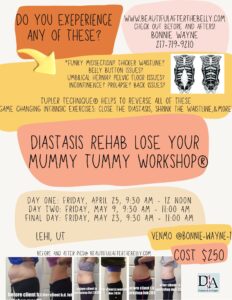RESEARCH-BASED PROGRAM
The Tupler Technique® is the only program with published research behind it, proving it to be effective in treating a diastasis recti. The results of a study* at Columbia University Program in Physical Therapy were conclusive: women utilizing the Tupler Technique® exercises had a smaller diastasis than the control group who did not do these exercises.
The word diastasis means separation. A diastasis recti is a separation of the rectus abdominis or the outermost abdominal muscles. When the muscles separate, the connective tissue that joins them stretches sideways. The more it stretches sideways, the thinner and weaker it becomes.
*Journal of Women’s Health Physical Therapy, Vol. 29, No. 1, Spring, 2005
CAUSE OF DIASTASIS
Everyone is born with their muscles separated. Whether it closes depends on the amount of force or pressure on the connective tissue that joins the outermost muscles. If the muscles close, they are always at risk for separating again when there is this continuous force on the connective tissue.
Force can be caused by weight gain in the abdominal area, the growing uterus during pregnancy, and using abdominal muscles incorrectly while doing sports and exercises (crunches, gymnastics, Pilates, yoga, tennis, golf and kickboxing).
ILL EFFECTS OF DIASTASIS
- Low back pain/pelvic floor dysfunction
- “Mummy Tummy” or “Guy Gut” caused by protruding organs
- Umbilical hernia
- Gastrointestinal problems
- Risk of ventral hernia with abdominal trauma
BENEFITS OF CLOSING A DIASTASIS RECTI
- Flat belly & smaller waist
- Relief of gastrointestinal problems
- Relief of back problems & pelvic floor dysfunction
- Better posture
- More effective pushing in labor
TUPLER TECHNIQUE AB REHAB
TUPLER TECHNIQUE HELPS UMBILICAL HERNIA
An umbilical hernia is a side effect of a diastasis recti. If this hernia is repaired without closing the diastasis recti, this hernia will most likely reoccur. The Tupler Technique® will not only close your diastasis, it will heal the umbilical hernia and turn your belly button from an “outie” to an “innie.”
IMPORTANCE OF PREPARING FOR ABDOMINAL SURGERY WITH THE TUPLER TECHNIQUE
Just as force on connective tissue makes a diastasis larger, force on sutures makes them come apart. If you strengthen and re-train your abdominal muscles before surgery, you will have the “muscle memory” to use them correctly during the recovery process which will maintain the integrity of the sutures. Activities of daily living (belly breathing, coughing, getting in and out of bed, standing correctly and having a bowel movement) can cause the sutures to separate. Learning to do these activities before surgery with the Tupler Technique® will minimize this effect.
PRODUCTS FOR PROGRAM
– Tupler Technique® Ab Rehab DVD
– Tupler Technique® Guidebook
“The Tupler Technique, a special abdominal exercise, is great for maintaining the results of stomach surgery… it helps to strengthen the side abdominal muscles so they don’t spread back out.” – Dr. Sharon Giese, Plastic Surgeon, NYC
TUPLER TECHNIQUE PERFECT PUSHING
PURPOSE OF PROGRAM
- Teaches you how to push with your strengthened and splinted abdominal muscles, while relaxing your pelvic floor muscles that you have strengthened and stretched during your pregnancy.
- Teaches you the 4 steps of the Tupler Technique® Program and how this program can be incorporated into pushing in labor as well as other exercise modalities and activities of daily living.
IMPORTANCE OF LEARNING HOW TO PUSH
- Pushing is a learned skill and must be practiced during pregnancy so it becomes second nature in labor.
- Women must learn how to work the abdominal muscles separately from the pelvic floor muscles.
- The abdominal muscles must be strengthened during pregnancy so they will be strong enough to push effectively in labor for as long as necessary.
- Splinting the abdominal muscles during labor keeps the uterus in the proper position to create a straight path for delivery.
PRODUCTS FOR PROGRAM
- Tupler Technique® Perfect Pushing DVD
- Coming Contractions pain management CD
- Tupler Technique® Guidebook
- Diastasis Rehab Splint®
BENEFITS OF PUSHING CORRECTLY
- Faster and controlled delivery
- Diastasis does not get larger
- Pelvic floor muscles are not weakened
“Just a note to thank you for preparing me both physically and mentally for the “marathon of labor,” as you call it. The Tupler Technique abdominal exercises I learned for pushing and to prevent back problems really worked in labor… Understanding how to push with a strengthened transverse muscle while relaxing the pelvic floor muscles gave me that mind body connection so necessary in pushing…” – Elle Macpherson (actress, model, mom)
DIASTASIS REHAB PROGRAMS
For Women, Men & Children
It is NEVER too late to close a diastasis! Closing your diastasis is all about healing the connective tissue. A diastasis can be closed on anyone at any time! How long it takes depends on the severity of your diastasis and your commitment to all 4 steps of the program.
PROGRAMS TO TREAT DIASTASIS RECTI
- Diastasis Rehab Lose Your Mummy Tummy
- Diastasis Rehab Say Good Bye to Your Gut, Guys
- Diastasis Rehab Belly Button Boogie
PRODUCTS TO TREAT DIASTASIS RECTI
- Diastasis Rehab Splint®
- Tupler Technique® Guidebook
DVDs:
- Diastasis Rehab Lose Your Mummy Tummy
- Diastasis Rehab Say Good Bye to Your Gut, Guys
- Diastasis Rehab Belly Button Boogie
4 STEPS OF TUPLER TECHNIQUE PROGRAM
- Tupler Technique® Exercises (Elevator, Contracting & Headlifts)
- Splinting with the Diastasis Rehab Splint
- Using your abdominals correctly with activities of daily living
- Getting up and down correctly
DESCRIPTION OF THE SIX-WEEK PROGRAM
The Tupler Technique® foundation program is six weeks. During the six weeks you will learn the 4-step Tupler Technique.® By week six, you will be able to incorporate the Tupler Technique® into any exercise routine. By this time, you will also start to see the healing effects on your body.
Julie Tupler, RN is an expert on treating
diastasis recti.
Dr. Oz (Oprah & Friends)
For Women, Men & Children For Pregnant Women For Abdominal Surgery



Hello,
After a C-section, my bellybutton is still flat, but it is a inne when I am lying down. Above the navel it has developed a small protusion. I have a DR I guess. Do you think the Tupler technique will help my to get my bellybutton back to normal (an inne) and get rid of the protrusion?
Yes!
Yes! Contact me on the “contact me” area to set something up!